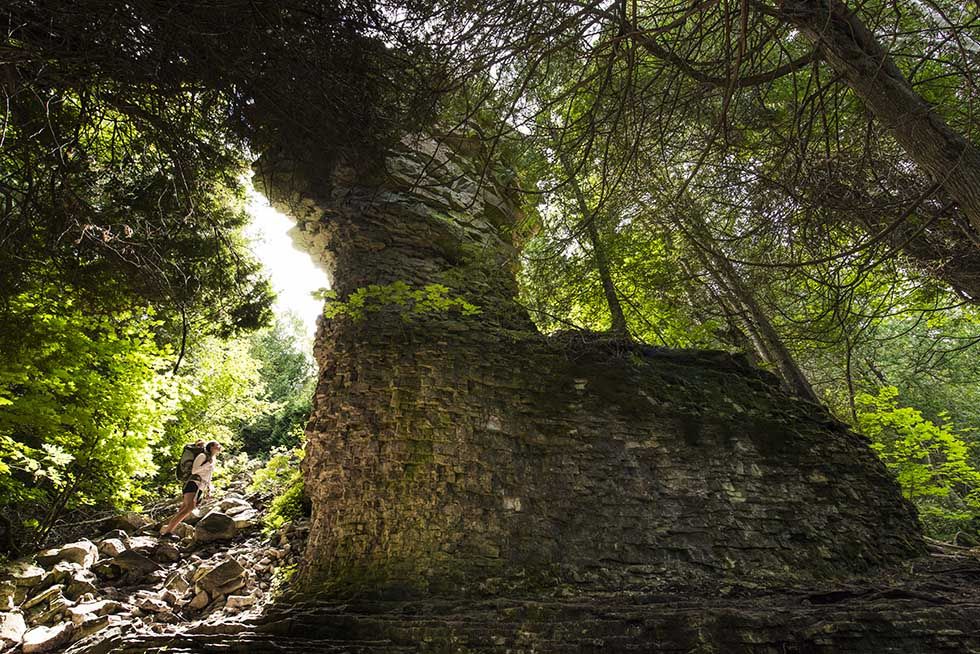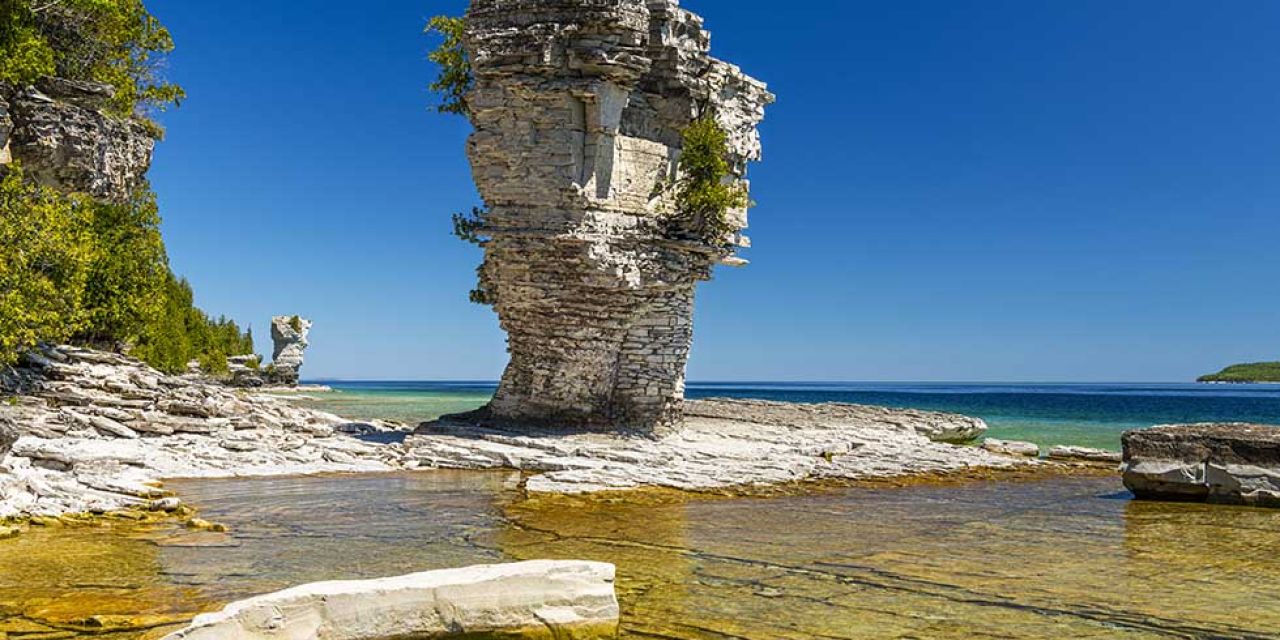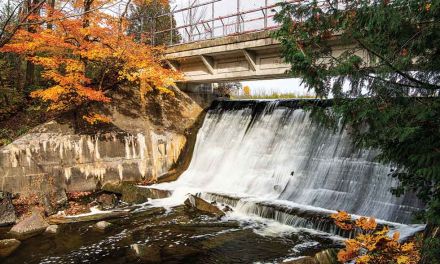Words by Cara Williams, Photography by Clay Dolan
Formed by the retreating of massive, continent-size glaciers which stood nearly two miles high, the Great Lakes are relatively young in geological terms. Still, it’s hard to believe that the rocks that we walk over on the northern Bruce Peninsula are up to 450 million years old. Devil’s Monument and Flowerpot Island, in the spectacular Fathom Five National Marine Park, are home to several towering sea stacks, a reminder of this land’s prehistoric beginnings. Slowly etched over years of exposure, these spectacular pillars formed as horizontally-bedded sedimentary rocks were carved into arches by waves pounding at the cracks in the stone, gradually wearing away the softer lower limestone from the harder dolomite top—once the arches collapsed, just the isolated stacks remain. The resulting shape resembles a giant flowerpot.In fact, there were originally three stacks on Flowerpot Island, but one fell due to natural erosion in 1903.
While early sailors likened the structures on Flowerpot Island to ancient Roman wine bottles, there is another myth behind the stacks—a native legend, not unlike William Shakespeare’s Romeo and Juliet, tells the ill- fated story of two lovers from opposing tribes. Shining Rainbow, a princess of the Ottawa tribe, and Bounding Deer, a prince of the Chippewa tribe, hid their affections from the elders. Knowing that neither family would approve of such a union, they chose to elope. Under a full moon the pair set off from the shores of the peninsula but were soon tracked and pursued by members of their tribes. In a desperate attempt to be free, the lovers pointed their canoe toward Manitoueses, a feared but sacred Island believed to be inhabited by ‘lesser devils’, including the dreaded Little Spirit. As their bow touched the shore, waves rose and billowed, followed by a deafening crash. Little Spirit had lay claim to the absconding lovers, petrifying them in rock and stone pillars on the shoreline. The passage of time and exposure have gradually weathered the stacks, but if you look closely at the large flowerpot you might still see the face of Bounding Deer, lost prince of the Chippewa.
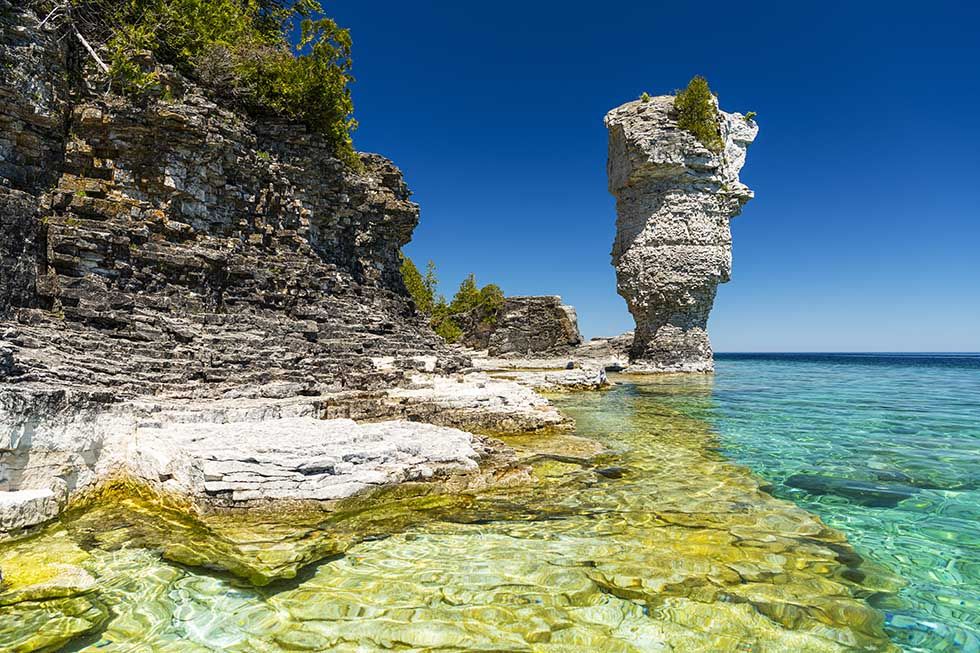
Fathom Five National Marine Park is packed with history, legends and lore, harbouring nearly two dozen shipwrecks— the limestone and shoal-lined channels are a graveyard to double-decked steamers and two-masted schooners dating back to 1867. In short; a scuba diver’s dream. But it’s the towering cliffs, unique limestone rock formations, caves, forests, glens and lighthouses all surrounded by crystal clear water that are perhaps the best attractions on the Peninsula. See also: a hiker’s dream.
Located 6.5 km from the tip of the Bruce Peninsula, access to Flowerpot Island is via water and there are several private tour companies that run glass-bottom boat sailing tours from Tobermory. Once on the island there are two main hiking routes: Loop Trail and Marl Trail. The Loop Trail is the main thoroughfare and takes you past both flowerpots, island caves, limestone swimming ledges and the Flowerpot Island lighthouse which dates back to 1897. Its rectangular steel tower stands 88 feet tall and sits perched atop the rocky cliffs of Castle Bluff. Before
it was decommissioned, its light was visible for just over 22 km. The lighthouse was de-staffed after the 1987 season, and the buildings sat vacant until Friends of Fathom Five, concerned about the deteriorating state of the structures, reached an agreement with the Coast Guard under which they were able to begin restoration work in 1996. A Lightkeeper’s Host Program was started in 1998 that allows volunteers to live at the station while performing minor maintenance and serving as site interpreters for visitors.
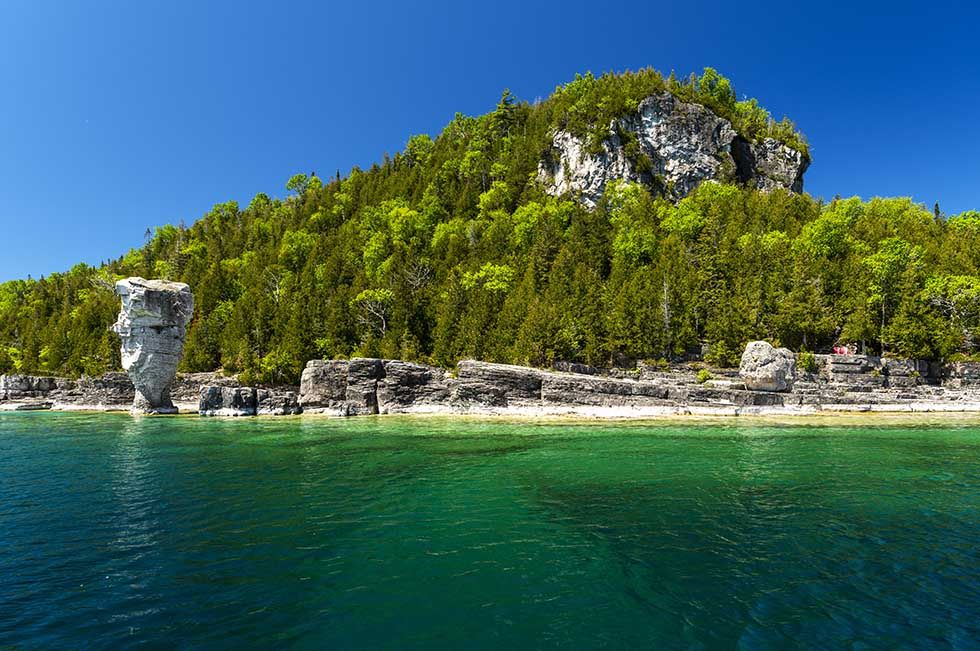
Continue hiking the loop trail towards the inner portion of the island, and the terrain becomes more rugged. Eventually you’ll end where you began; the docks at Beachy Cove. The Marl Trail, described as moderate level hiking, is a 1.2km out and back trail that leads down to the north-western coast past the campground—camping is permitted on Flowerpot (if you manage to snag a campsite before they’re fully booked). Staying overnight lets you explore the island with fewer people, so when the last boat leaves around 6 pm, you’ll have the island to yourself and because the island is a designated dark sky preserve, void of light pollution it boasts incredible stargazing.
Hidden in the craggy cliffs along the north-eastern shore of the Bruce Peninsula, erosion has carved the soft limestone like a spoon, leaving magnificent caverns and caves including Cave Point, Indian Head Cove and the famed Grotto. Accessible from the water or via the Georgian Bay Trail or Marr Lake Trail, the interior of the Grotto is an open cavity filled with remarkably clear, turquoise waters. Here, great blocks of dolomite, undercut by waves, have plummeted from the cliffs above and can be clearly seen below the surface. Inside the cavern the water appears iridescent thanks to light emanating from an underwater tunnel. The Grotto and Indian Head Cove are two of the top tourism attractions in Ontario, and online advanced reserved parking is required.
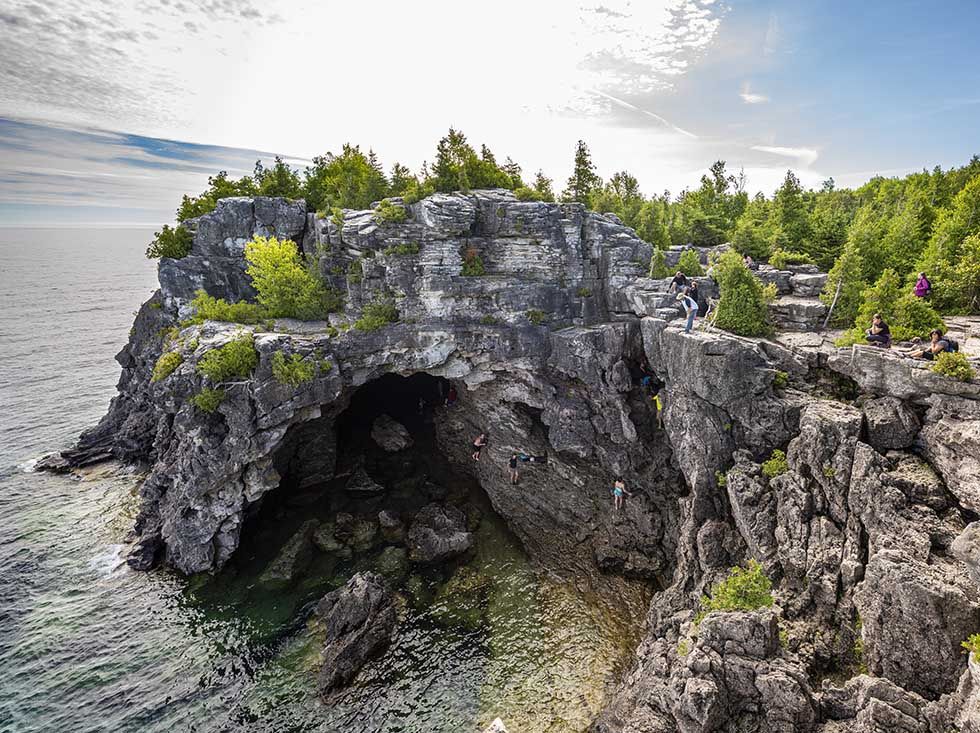
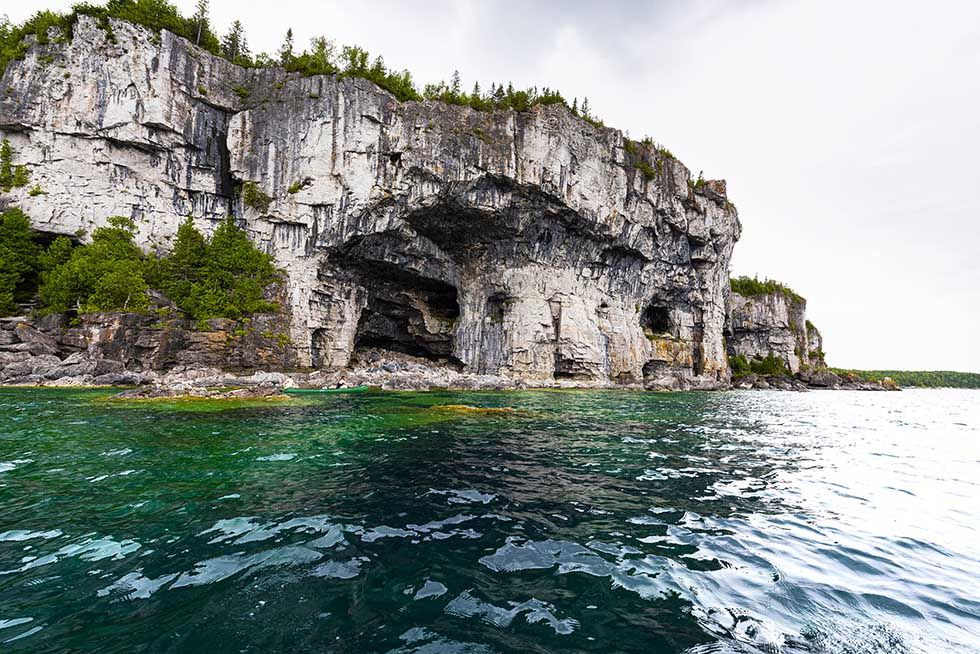
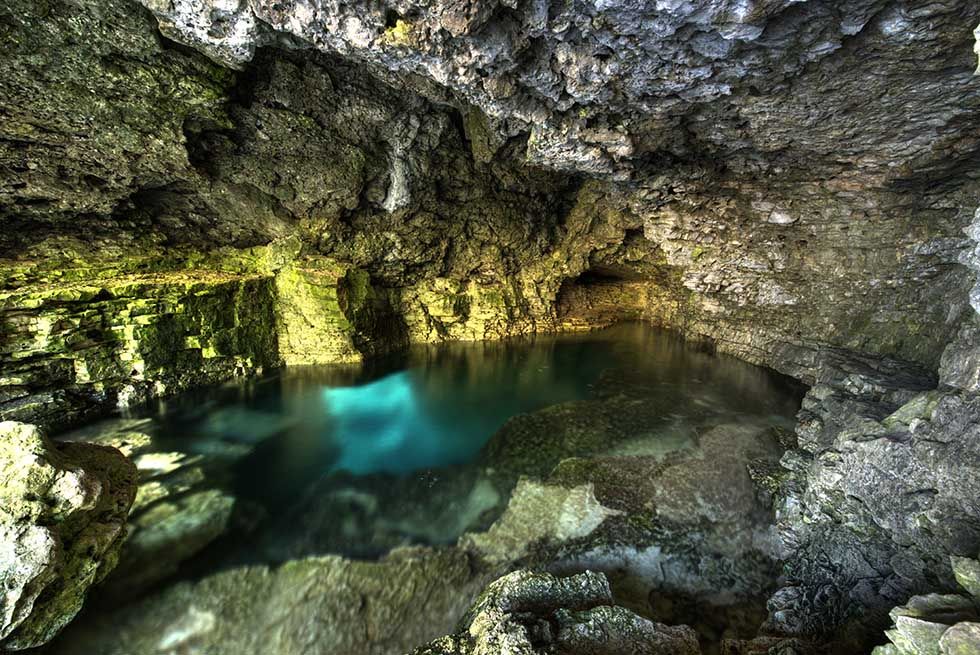
Water and weather continue to play a role in shaping the Escarpment as rainwater, waves and snow melt penetrate the porous dolostone to create karst features like caves, crevices and yes, more sea stacks. Nowhere is this more prevalent than on the north-eastern shores of Bruce Peninsula. Devil’s Monument, a sea stack formed 5,500 years ago by glacial Lake Nipissing, is directly on the Bruce Trail, accessible from the end of Cape Chin North Road.
Also known as the Devil’s Pulpit, the hike to the Monument is only about a kilometre but the trail is steep, rocky and usually quite slippery. This section of the Bruce Trail arguably boasts the most incredibly breathtaking views over the outcropping of limestone and shale cliffs that are suspended high above Georgian Bay. The largest land-based flowerpot on the Bruce, Devil’s Monument stands 14 metres tall and because freshwater stacks are more hospitable to vegetation than ocean sea stacks, it has sprouted impressive displays of pines, shrubs and grasses. Just beyond the Monument lookout is an iron staircase leading to its base. Follow the path and you’ll soon find yourself on a pristine pebble beach, surrounded by the crystal-clear turquoise Bay waters reminiscent of the Caribbean. You may want to stay here a while. If you do manage to tear yourself away from the water’s edge, head back up the staircase and continue the loop north for more incredible views—this hike has often been described as “the most spectacular, the most varied, and the most beautiful section of the entire Bruce Trail.”
The craggy shorelines of Georgian Bay and the islands of Fathom Five National Marine Park are protected within the UNESCO World Biosphere Reserve, and are considered one of the planet’s natural wonders. Unsurprisingly the uniqueness of the landscape attracts thousands of visitors each year and while the natural elements continue to play a role in changing the landscape of the Escarpment, humans should not.
Please help keep these precious natural wonders safe so that future generations can hike, camp, swim and learn about the incredible history of the northern Bruce Peninsula.
